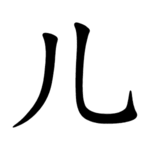Radical 10
| 儿 | ||||
|---|---|---|---|---|
| ||||
| 儿 (U+513F) "legs" | ||||
| Pronunciations | ||||
| Pinyin: | ér (SC), rén | |||
| Bopomofo: | ㄦˊ (SC), ㄖㄣˊ | |||
| Gwoyeu Romatzyh: | erl (SC), ren | |||
| Wade–Giles: | êrh2 (SC), jên2 | |||
| Cantonese Yale: | yàhn | |||
| Jyutping: | jan4 | |||
| Pe̍h-ōe-jī: | jî | |||
| Japanese Kana: | ジン jin / ニン nin (on'yomi) | |||
| Sino-Korean: | 인 in | |||
| Names | ||||
| Chinese name(s): | 兒字底/儿字底 érzìdǐ | |||
| Japanese name(s): | 人繞/にんにょう ninnyō 人足/ひとあしhitoashi | |||
| Hangul: | 어진사람 eojinsalam | |||
| Stroke order animation | ||||
 | ||||

Radical 10 or radical legs (儿部) meaning "legs" is one of 23 of the 214 Kangxi radicals that are composed of 2 strokes.
In the Kangxi Dictionary, there are 52 characters (out of 49,030) to be found under this radical.
儿 is also the 14th indexing component in the Table of Indexing Chinese Character Components predominantly adopted by Simplified Chinese dictionaries published in mainland China. In addition, this radical is commonly pronounced ér among Simplified Chinese users as 儿 is the simplified form of 兒 ér. However, the meaning of 儿 as a radical is irrelevant to 兒.
Evolution
Derived characters
| Strokes | Characters |
|---|---|
| +0 | 儿 |
| +1 | 兀 |
| +2 | 允 兂 (=簪 -> 竹) 元 |
| +3 | 兄 |
| +4 | 充 兆 兇 先 光 兊 (=兌) 尧SC (=堯 -> 土) |
| +5 | 克 兌 兎JP/variant (=兔) 兏 (=長 -> 長) 児JP (=兒) 兑SC/HK (=兌) |
| +6 | 免 兒 兓 兔 兕 兖SC/variant (=兗) |
| +7 | 兗 兘 兙 |
| +8 | 党 (also SC/JP form of 黨 -> 黑) 兛 |
| +9 | 兜 兝 兞 |
| +10 | 兟 兠 |
| +11 | 兡 |
| +12 | 兢 |
| +14 | 兣 |
| +18 | 兤GB TC variant |
| +19 | 兤Traditional variant |
Sinogram
The radical is also used as an independent Chinese character. It is one of the Kyōiku kanji or Kanji taught in elementary school in Japan.[1] It is a 4th grade kanji[1] It means child, and sometimes simply means erhua phonetically . 兒 is sometimes used to differentiate when it specifically means child and not phonetic use
References
- ^ a b "The Kyoiku Kanji (教育漢字) - Kanshudo". www.kanshudo.com. Archived from the original on March 24, 2022. Retrieved 2023-05-06.
Further reading
- Fazzioli, Edoardo (1987). Chinese calligraphy : from pictograph to ideogram : the history of 214 essential Chinese/Japanese characters. calligraphy by Rebecca Hon Ko. New York: Abbeville Press. ISBN 0-89659-774-1.
- Leyi Li: “Tracing the Roots of Chinese Characters: 500 Cases”. Beijing 1993, ISBN 978-7-5619-0204-2
External links

- Unihan Database - U+513F
- v
- t
- e
- 211 齒
- 214 龠

















